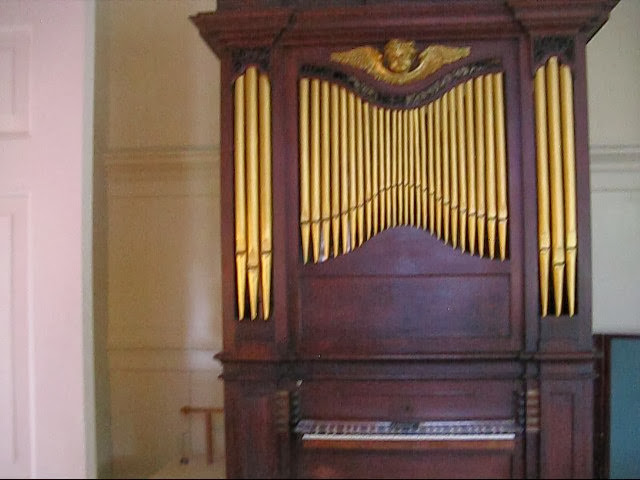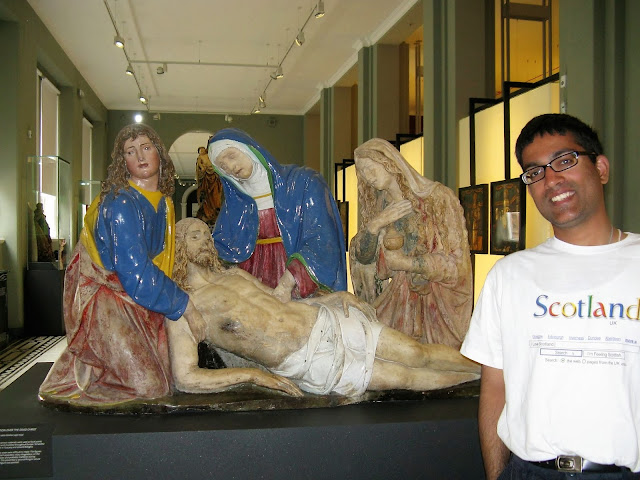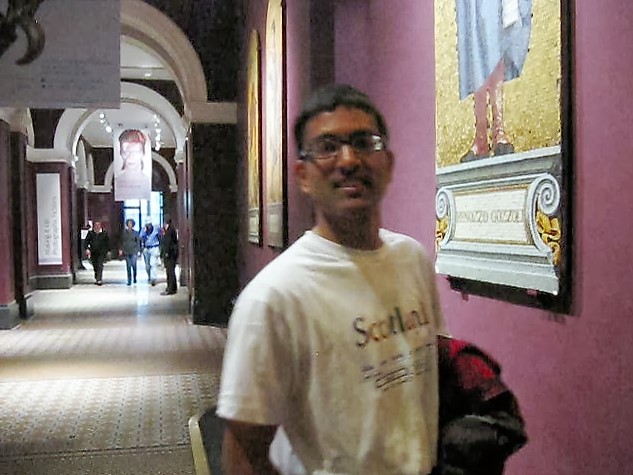DAY 11, MAY 8, 2013, KEW GARDENS(18°C-9°C)
Royal Botanic Gardens, Kew:
The Royal Botanic Gardens, Kew, usually
referred to as Kew Gardens, comprises 121 hectares of gardens and
botanical glasshouses between Richmond and Kew in Richmond upon
Thames in southwest London,
Created in 1759, the gardens have the
world's largest collection of living plants. The claim on the board is true... from botany to biodiversity, tropics to tree tops comprehensive experience.
The organization employs 650 scientists and other staff. The living collections include 30,000 different kinds of plants.
Tulips here...
The organization employs 650 scientists and other staff. The living collections include 30,000 different kinds of plants.
Tulips here...
The Palm House:
This is The Palm House built
between 1844 and 1848, and was the first large-scale structural use
of wrought iron. It is considered " the world's most
important surviving Victorian glass and iron structure." The
structure's panes of glass are all hand-blown.
Griffin holding the royal coat of arms.
Griffin is a legendary creature with
the body, tail, and back legs of a lion; the head and wings of an
eagle; and an eagle's talons as its front feet. Because the lion was
traditionally considered the king of the beasts and the eagle the
king of birds, the griffin was an especially powerful and
majestic creature. The griffin was also thought of as king of all
creatures. Griffins are known for guarding treasure and
priceless possessions.
Inside the palmhouse.
A space frame of wrought iron arches, held together by horizontal tubular structures containing long prestressed cables, supports glass panes which were originally tinted green with copper oxide to reduce the significant heating effect.
The 19m high central nave is
surrounded by a walkway at 9m height, allowing visitors a closer look
upon the palm tree crowns.
Chilean firebush--saw it in the wild in Argentina in Dec 2013.
Palms.
Down the spiral staircase in the palmhouse.
Aquarium:
Nice Aquarium here.
Barbel on a fish is a slender, whiskerlike tactile organ near the mouth. They house the taste buds and are used to search for food in murky water.
The Waterlily House:
This is the hottest and most humid of the houses at Kew and contains a large pond with varieties of water lily, surrounded by a display of economically important heat-loving plants. It closes during the winter months.
It was built to house the Victoria
amazonica, the largest of the Nymphaeaceae family of water lilies.
This plant was originally transported to Kew in phials of clean water
and arrived in February, 1849, after several prior attempts to
transport seeds and roots failed. Although various other members of
the Nymphaeaceae family grew well, the house did not suit the
Victoria, because of a poor ventilation system, and this
specimen, was moved to a smaller house.
The temperate house:
The temperate house in the
background--This greenhouse has twice the floor area of the
Palm House and is the world's largest surviving Victorian glass
structure. It contains plants and trees from all the temperate
regions of the world. It was commissioned in 1859 . Covering 4880
square metres, it rises to a height of 19 metres. Intended to
accommodate Kew's expanding collection of hardy and temperate plants,
it took forty years to construct, during which time costs soared.
There is a viewing gallery in the
central section from which visitors may look down on that part of the
collection.
They even have the tallest indoor plant, the chilean wine palm.
Date Palm
Cultivated for over 8000 years, the Date Palm (Phoenix dactylifera) is said to have 800 different uses. Each tree can produce over 50kg of fruit or ‘dates’ every year.
Dates have a high sugar content, which becomes more concentrated as they are dried. A favourite of the ancient Egyptians and Romans, they are still a staple food in the desert regions of northern Africa and the Middle East.
Date Palm leaves are traditionally used in the Christian celebration of Palm Sunday: the Sunday before Easter. The day commemorates the spreading of palm leaves and clothing in Jesus’ path as he entered Jerusalem prior to his crucifixion.
Huge lupines.
Bromeliads
Anthurium, small flower on a fleshy stem. The spadix is often elongated and the flower forms a hood around the spadix.
We saw several anthuriums in Hawaii.
This gallery closed in Aug 2013 for a 5
year renovation ... thankfully we visited in May and saw it.... they
have a grant of 15 million pounds and will reopen in 2018.




Treetop walkway:
Treetop walkway opened in 2008. This
walkway is 18 metres (59 ft) high and 200 metres (660 ft) long and
takes us into the tree canopy of a woodland glade.
We can ascend and descend by stairs and
a lift is available for the disabled. The floor of the walkway is
made from perforated metal and flexes as it is walked upon. The
entire structure sways in the wind.
In the South East corner of Kew Gardens
stands the Great Pagoda, erected in 1762, from a design in imitation
of the Chinese Ta.
Each storey finishes with a projecting
roof, after the Chinese manner, originally covered with ceramic tiles
and adorned with large dragons; a story is still propagated that they
were made of gold and were sold by George IV to settle his debts.
In fact the dragons were made of wood painted gold, and simply
rotted away with the ravages of time. The walls of the building
are composed of brick. The staircase, 253 steps, is in the centre of
the building. The Pagoda was closed to the public for many years, but
was reopened for the summer months of 2006, now permanently.
We enjoyed the grounds as entry inside is
forbidden.
Kew palace:
Kew Palace is the smallest of the
British royal palaces. It was built by a Dutch merchant in 1631.
It was later purchased by George III. The construction method is
known as Flemish bond and involves laying the bricks with long and
short sides alternating. This and the gabled front give a Dutch appearance.
George III's residency of the Dutch
House was originally intended to be brief, a temporary residence
while his new castellated palace in the Gothic style was built - at
first the Royal Family resided at Richmond Lodge but as the family
became larger it became necessary to take over other properties on
Kew Green, which included the Dutch House.
George III's wife, Queen Charlotte died
at the Dutch House on 17 November 1818. On ascending the throne in
1837 Queen Victoria gave most of Kew Gardens to the nation, retaining
for her own use only a small summer house once belonging to Queen
Charlotte. This is known as "Queen's Cottage" but Queen
Victoria seldom visited it and to mark her Golden Jubilee in 1887 she
presented this also to the country.
Wax bust of George III by madame
Tussoud.
The palace is very simple. There was
piped drama echoing in the room.
We went to Victoria and Albert museum
next.
Prince Albert appears within the main
arch above the twin entrances, Queen Victoria above the frame around
the arches and entrance,
the tower above the main entrance
has an open work crown surmounted by a statue of fame,
The Victoria and Albert Museum (often
abbreviated as the V&A), London, is the world's largest museum
of decorative arts and design, housing a permanent collection of over
4.5 million objects. It was founded in 1852 and named after Queen
Victoria and Prince Albert.
This area has become known as
"Albertopolis" because of its association with Prince
Albert, the Albert Memorial and the major cultural institutions with
which he was associated including the Natural History Museum, the
Science Museum and the Royal Albert Hall.
In 2000, an 11 metre high, blown glass
chandelier by Dale Chihuly was installed as a focal point in the
rotunda at the V&A's main entrance.




Medieval and Renaissance Galleries seen
here...
The sculpture collection at the
V&A is the most comprehensive holding of post-classical
European sculpture in the world. There are 22,000 objects
in the collection that cover the period from about 400 AD to 1914.
Cupids as Caryatids and marble, maternal affection. Both english sculptures, room 22
Moses
Stained glass.
The three Marys with Jesus: the Three Marys are the three whom the Gospel of John mentions as present at the crucifixion of Jesus:
Mary (mother of Jesus);
His mother's co sister Mary, the wife of Cleopas; Mary Magdalene.
Awesome mosaics.
All uses of sculpture are represented, from tomb and memorial, to portrait, allegorical, religious, mythical, statues for gardens including fountains, as well as architectural decorations. Materials used include, marble, alabaster, stone, terracotta, wood (history of wood carving), ivory, gesso, plaster, bronze, lead and ceramics.
The collection of Italian, Medieval,
Renaissance, Baroque and Neoclassical sculpture (both original and in
cast form) is unequalled outside of Italy.
We went to the JEWELLERY SECTION on the 3rd floor and gaped at the pieces till the museum closed.
The jewellery collection, containing
over 6000 items is one of the finest and most comprehensive
collections of jewellery in the world and includes works dating
from Ancient Egypt to the present day, as well as jewellery designs
on paper. The museum owns pieces by renowned jewelers Cartier,
Jean Schlumberger, Peter Carl Fabergé and Lalique.
Other items in the collection
include diamond dress ornaments made for Catherine the Great,
bracelet clasps once belonging to Marie Antoinette, and the
Beauharnais emerald necklace presented by Napoleon to his adopted
daughter Hortense de Beauharnais in 1806.
is the gallery we saw.
National Gallery:
We rushed in to the national gallery next.
AWESOME FLOOR MOSAICS.
SIXTH SENSE--represented by poet Edith Sitwell below.
Sitwell had angular features resembling Queen Elizabeth I (they also shared the same birthday) and stood six feet (183 cm) tall, but often dressed in an unusual manner with gowns of brocade or velvet with gold turbans and a plethora of rings - her jewellery may be seen in the jewellery galleries of the Victoria and Albert Museum in London. Her unusual appearance provoked critics almost as much as her verse, and throughout her life she was the subject of more or less virulent personal attacks.
The first picture that greets visitors
to the National Gallery is not an Old Master, nor an Impressionist.
Nor does it even hang on a wall. Set into the floor of the first
landing in the Gallery's Portico entrance is 'The Awakening of the
Muses', a marble mosaic laid in 1933 by the Russian-born artist Boris
Anrep (1885-1969).
Between 1928 and 1933, the National
Gallery commissioned Anrep to lay two mosaic pavements in the
vestibule of the Main Hall to illustrate 'The Labours of Life' and
'The Pleasures of Life'. this is the 3rd and final project...
In 1952, aged 67, Anrep laid this
third pavement, 'The Modern Virtues'. it lies underfoot in a
busy public place.
In Humor, the socialite Lady Diana
Cooper, dressed as Britannia, crowns a paunchy, grinning Mr Punch.
The philosopher Bertrand Russell as
Lucidity, removes the last remaining garment, a blindfold, from the
young woman representing Truth he's just pulled up from a well.
Modern Virtues in the north vestibule
(1952) is a record of the intellectual life of 1930s and 1940s.
Compromise is presented by the American actress Loretta Young,
wearing a Phrygian cap as well as a crown; Curiosity is Lord
Rutherford with a splitting atom; Sir Winston Churchill defies a
beast in a shape of swastika (Defiance). The ballerina Margot Fonteyn
listens to the writer and musician Hon. Edward Sackville-West playing
the harpsichord (Delectation); Lady Diana Cooper as Britannia crowns
Punch (Humour); the poet T. S. Eliot features in Leisure, The
astronomer Fred Hoyle, Augustus John and the poet Edith Sitwell and
are portrayed respectively in Pursuit, Wonder and Sixth Sense (named
after the poem by Gumilyov). Compassion is a portrait of Akhmatova
surrounded by the horrors of war. She is looking towards another
panel which depicts Anrep's gravestone, linking together his art and
her poetry.


We called it a day when the gallery closed.
The National Gallery was built between 1834-1837 and is one of London's greatest art galleries, housing one of the most extensive and valuable collection of paintings in the world including works by Cézanne, Constable, El Greco, Degas, Gainsborough, Leonardo Da Vinci, Dürer, Manet, Murillo, Raphael, Rembrandt, Rossetti, Rubens, Titian, Velázquez etc.
Palace of Westminster here.

On the north side of the square is the National Gallery seen here...and to its east St Martin-in-the-Fields Church. The statue seen is that of George IV and this is the main entrance to the National Gallery in Trafalgar Square.
Granite statue to honour Admiral Nelson (1758-1805), following his victory in the Battle of Trafalgar in 1805. It is five metres high and stands on a bronze platform made from old guns from the Woolwich Arsenal Foundry. The 160ft/55m high column was completed in 1843 and the bronze reliefs are cast from captured French cannons and show scenes from the victorious battle over the enemy fleets. 'England expects every man will do his duty', the words associated with Nelson's flagship HMS Victory are inscribed below.
The National Gallery was built between 1834-1837 and is one of London's greatest art galleries, housing one of the most extensive and valuable collection of paintings in the world including works by Cézanne, Constable, El Greco, Degas, Gainsborough, Leonardo Da Vinci, Dürer, Manet, Murillo, Raphael, Rembrandt, Rossetti, Rubens, Titian, Velázquez etc.
Palace of Westminster here.

DAY 12, MAY 9, 2013:
Our cab from exclusive airports was due
at the hotel at 10.20. We took the tube to trafalgar square for a
final look at 8.30!!
Trafalgar Square:
The square is named in honor of
Admiral Lord Nelson's victory over the combined Spanish and French
navy off Cape Trafalgar on October 21st 1805.
The fountains were added in 1845, and
the mermaids, dolphins and tritons (which are the male figures with
tails like fish) were installed later. The fountains operate on most
days.
On the north side of the square is the National Gallery seen here...and to its east St Martin-in-the-Fields Church. The statue seen is that of George IV and this is the main entrance to the National Gallery in Trafalgar Square.
The square was once famous for its
feral pigeons, and feeding them was a popular activity. Their
droppings disfigured stonework, and the flock, estimated at its peak
to be 35,000, was considered a health hazard. In February 2001, the
sale of bird seed in the square was stopped and other measures
introduced to discourage the pigeons, including the use of trained
birds of prey.
Groups of supporters continued to feed
the birds, but in 2003 the then-Mayor, Ken Livingstone, enacted
bylaws to ban the feeding of pigeons.
Now there are no pigeons...
Setup for a music concert going on.
Could have climbed on to the lions if this stage setup paraphernalia
had not closed down the area.
Nelson’s Column:
Granite statue to honour Admiral Nelson (1758-1805), following his victory in the Battle of Trafalgar in 1805. It is five metres high and stands on a bronze platform made from old guns from the Woolwich Arsenal Foundry. The 160ft/55m high column was completed in 1843 and the bronze reliefs are cast from captured French cannons and show scenes from the victorious battle over the enemy fleets. 'England expects every man will do his duty', the words associated with Nelson's flagship HMS Victory are inscribed below.
The bronze 'guardian' lions at the base of Nelson's Column arrived in 1868. The 4 lions are said to protect Nelson’s Column.
Statues
There are four plinths for statues in
the square. Bronze statues stand on three of them: General Sir
Charles James Napier is on the plinth in the southwest of the square,
Major General Sir Henry Havelock on the southeast plinth and King
George IV on the northeast plinth.
The fourth plinth, in the northwest of
the square, was empty for many years. The current installation
'Nelson's Ship in a Bottle' MBE is by Yinka Shonibare MBE and was
unveiled in the square in May 2010. The statue to General Charles
James Napier (1782-1853) who was Commander-in-Chief in India. Its a
pity it isn't replaced by a statue commemorating another Napier,
namely the Scottish mathematician John Napier (1550-1617), who was
the inventor of logarithms which revolutionised mathematical
calculation methods.
Here we are at the Charing Cross tube
station waiting for the ride back.
The electronic board says our train is
due in 2 minutes...
Reached the hotel, called a cab, went to the
airport to fly home... end of an awesome holiday in England, and
Scotland.
The next post is the start of the report on our recent Canadian vacation:
http://adventuretrav.blogspot.com/2017/09/how-to-plan-trip-to-canada.html
The next post is the start of the report on our recent Canadian vacation:
http://adventuretrav.blogspot.com/2017/09/how-to-plan-trip-to-canada.html












































































































































